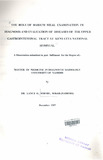The role of barium meal examination in diagnosis and evaluation of diseases of the upper gastrointestinal tract at Kenyatta National Hospital
Abstract
In this prospective study over a period of six months (May-November 1997), to
determine the role of Barium Examination in evaluation of upper gastro-intestinal tract
(GIT) diseases at Kenyatta National Hospital, a total of 320 patients were investigated.
During this period 520 patients were booked for upper GIT examination. 200 patients
were not investigated because half of them never turned up while the rest were re-booked
as only one fluoroscopy unit was operational. Of those who underwent the investigation
183 (57.2%) were females and 137(42.8%) were males.
After double contrast upper GIT examination the results showed 100 (31.3%) patients to
have normal upper GIT though they may have been sick elsewhere. Suspected peptic
ulcer disease (PUD) was by far the leading clinical diagnosis prompting clinicians to
request for an upper GIT barium examination. Among the 258(80.6%) patients thought
to have PUD 70(27.1%) were found to be normal, 130 (50.4%) had duodenal ulcer and
36 (14.0%) had duodenitis.
The next leading provisional clinical diagnosis requiring upper GIT investigation was
oesophageal carcinoma with 14 (4.4%) cases followed by gastric carcinoma with
10(3.1%) cases.
Patients of all age groups were examined and included in the study so long as there was
no contraindication. The mean age group was 25-30 years with a total number of
99(31%) patients.
Those undergoing upper GIT barium examination were questioned on their blood group.
76(23.8%) out of 320 patients could recall their blood group which was recorded down.
The majority of these were blood group "0" (45/76).
The low figure of those who know their blood group could be explained, among other
reasons, by the fact that some patients were either too young or too old to understand
blood group, or had not even been tested. It is therefore appreciated that the best way to
correlate blood group and upper GIT diseases is to perform venipuncture (or finger prick)
for blood grouping on every patient undergoing upper GIT barium investigation.
Citation
A Dissertation Submitted In Part Fulfilment For The Degree Of:-Master Of Medicine In Diagnostic Radiology University Of Nairobi, 1997Publisher
University of Nairobi

